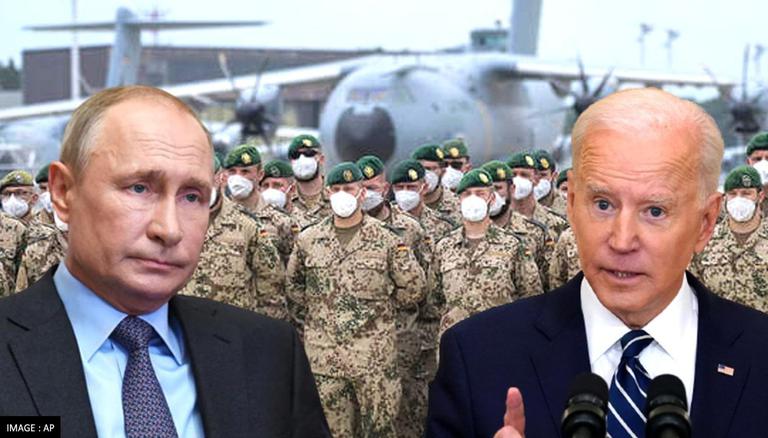President Joe Biden on Tuesday directed additional US troops to NATO’s Eastern flank as Russia allegedly moved a step closer toward a large-scale invasion of Ukraine.
“As Russia contemplates its next move, we have our next move prepared as well,” Biden told reporters at the White House, The Hill reported.
“Today, in response to Russia’s admission that it will not withdraw its forces from Belarus, I have authorized additional movements of US forces and equipment already stationed in Europe to strengthen our Baltic allies, Estonia, Latvia and Lithuania,” he said.
Washington has already deployed or repositioned some 6,000 US forces to Germany, Poland and Romania near the countries’ borders with Ukraine as Russia has gathered an estimated 190,000 troops near its border with the former Soviet country and in Belarus.
Western nations fear Moscow may soon move to mount a large-scale attack on Ukraine, a concern amplified by Russian President Vladimir Putin on Monday recognizing two separatist regions of Ukraine — the Donetsk People’s Republic and Luhansk People’s Republic — as independent and ordering troops to the area.
Belarus also said on Monday that the withdrawal from its territory of Russian troops, forces there under the guise of joint war games between the two countries, would depend to a large extent on NATO pulling back its forces.
“He is setting up a rationale to take more territory by force, in my view,” Biden said of Putin in remarks from the East Room, adding, “This is the beginning of a Russian invasion of Ukraine.”
Biden did not say how many troops would be sent to the three Baltic nations or where they would be repositioned from but said it was “totally defensive moves on our part” and the United States has “no intention of fighting Russia”.
“We want to send an unmistakable message that the United States together with our allies will defend every inch of NATO territory and abide by the commitments we made to NATO,” he said, adding that Washington will also continue to provide defensive assistance to Ukraine.
A senior defense official told reporters later Tuesday that the extra forces will be comprised of airmen and ground troops that will move “to NATO’s Northeastern and Southeastern flanks in coming days and are expected to be in place later this week”.
The forces include an infantry battalion task force of approximately 800 personnel that will move from Italy to the Baltic region, up to eight F-35 fighter jets sent from Germany to “several operating locations along NATO’s Eastern flank”, a battalion of 20 AH-64 Apache helicopters moved from Germany to the Baltic region and 12 Apache helicopters moving from Greece to Poland.
The additional personnel are being repositioned temporarily “to reassure our NATO allies, deter any potential aggression against NATO member states and train with host nation forces”, the official added.
In the same speech, Biden announced that the US would also sanction Russian sovereign debt and Russian elites as well as their family members.
A bipartisan group of lawmakers issued a memo on Tuesday to Biden reminding the commander-in-chief that he had previously pledged to not send US troops into Ukraine, although he said the decision could change.
“I’m urging Pres Biden to follow the Constitution and the law and receive authorization from Congress before involving US forces in Russia-Ukraine conflict,” said Rep. Peter DeFazio, adding, “The American people deserve to have a say before we become involved in yet another foreign conflict.”
Separately, German Defense Minister Christine Lambrecht said on Tuesday that German troops could be sent to Lithuania and other countries on NATO’s Eastern flank a day after Russia formally recognized two regions of Ukraine as independent, DW reported.
“It is clear that we need to apply stricter deterrence measures,” Lambrecht told a joint news conference with her Lithuanian counterpart at the Rukla military base.
“I want to underscore that we are ready to send more troops, land and air. We are ready to send more troops also to Lithuania and signal that we are together with partners and we are a trustworthy partner in a crisis,” she said.
German soldiers comprise about half of a 1,100-strong NATO battle group in Lithuania that includes troops from Belgium, the Czech Republic, Luxembourg, the Netherlands and Norway.
READ ALSO: How China reacts to the Russia-Ukraine crisis
Lambrecht said that these proposed reinforcements could come on top of a contingent of some 360 extra German soldiers already en route to Lithuania on Tuesday.
Norway also announced that it was adding 50-60 soldiers to the group.
UK Prime Minister Boris Johnson also said 800 British soldiers were being added to the NATO battlegroup in Estonia, and that more could be sent “to help protect allies if NATO makes a request”.
British Defense Minister Ben Wallace then announced that a separate group, the Joint Expeditionary Force (JEF), which includes the UK, Denmark, Estonia, Finland, Iceland, Latvia, Lithuania, the Netherlands, Norway and Sweden, would soon be engaging in military exercises “in Northern Europe”.
UK and Baltic states’ troops will participate in “preventative and proportionate” exercises “at sea, on land, and in the air”.













